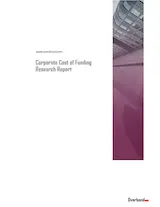From the event:
Overbond’s National Issuer Conference Call discusses the financial technology environment and trends we saw in 2016, along with occurrences in debt capital markets for 2016 and what corporate treasurers can expect in the upcoming year. Finally, we will discuss the role of technology in corporate growth initiatives, and regulatory considerations.
The Financial Technology Landscape and Notable Facts From 2016
The momentum surrounding financial technology is incredibly strong. In 2015, investment in financial technologies hit $19 billion, and we are already on track to surpass that this year. In capital markets specifically, the theme surrounding this movement is collaboration - collaboration with all parties involved to evolve the market ecosystem.
The world is changing, and capital markets will change with it. Ernst & Young stated this year that innovation within capital markets is no longer optional. Investment banks are faced with high structural costs, heavy capital changes, and stagnant returns. They have been focused on delivering changes mandated by regulators and external threats. These regulatory deadlines are exhaustive to meet and result in a lack of focus on investing in initiatives to ultimately build innovative ways to serve clients. These same financial service providers are working with financial technology companies around the world to act to supplement this. This is the very reason financial technology growth has occurred so rapidly, and we can be assured that capital markets will be no stranger to this.
Debt Capital Markets in 2017
This year, we saw four main themes pertaining to debt capital markets. First with fixed income markets. We saw two things occur in 2016 - Policy-driven market volatility, and widening policy divergence. In terms of policy-driven market volatility - 2016 saw record-low bond yields in UK in the wake of Brexit, sending global bond yields to record lows. However, since Trump’s election victory in the US, inflation expectations there have been surging rapidly, leading to the sell-off of US long bonds and rally in broad equity markets.
In terms of widening policy divergence - debt capital market discrepancies between the US and the rest of the developed markets, especially in Europe. Whereas ECB is likely to extend its €80 billion-a-month bond-purchase program, the Fed in the US is poised to hike its interest rate in December. The two diverge at a time when their economies are at opposite ends of the spectrum. While the eurozone struggles with high unemployment, weak inflation and near-flat growth, the U.S. economy has seen remarkable strength. That will leave Yellen no choice but to move the U.S. to higher interest rates. Relating this back to home, like Europe, Canada is unlikely to follow in the Fed’s footsteps anytime soon.
With bond yields reaching record lows this year, It can be expected that global interest rates will continue to be low, driven by continued easing from the European Central Bank and the Bank of Japan. In addition, growth prospects and lower-for-longer inflation in the eurozone, Japan, the UK, and to some extent in the USA, indicate an unsupportive backdrop for higher interest rates globally. In 2016, we saw companies like Unilever and Toyota issue at near 0% yields and Henkel and Sanofi issue with negative yields. Further, as reported by Bloomberg, average corporate bond yields in Japan were reported at 0.17%, down from 0.33% a year earlier.
Another big theme this year was robust bond issuance. Corporate bond issuance will remain robust, but may contract marginally unless other factors, like M&A, come into play. Government bond issuance is likely to pick up the slack, as many governments will continue to take advantage of the low interest rate environment. For example, Canadians are seeing Prime Minister, Justin Trudeau, committing to highly accommodative fiscal policy that includes large infrastructure spending financed primarily through the issuance of debt. In the U.S., the Trump administration is also supportive of increasing infrastructure spending which in turn will result in debt issuance ranging from municipalities to US treasuries.
Factors we should watch out for in terms of this
In 2017, the rising rates environment in US and dovish stance of Bank of Canada will potentially attract more Canadian corporate issuers (e.g. Rogers) who used to frequently come to US bond market to issue in CAD market instead; also, Canadian issuers with heavy US operations might choose to issue CAD bonds as well and then swap back to USD. Additionally, Trudeau and Trump’s plans to increase infrastructure spending may lead to a surge in infrastructure sector bond issuance in 2017 and beyond. Finally, Oil price are likely to pick up as well, creating opportunistic credit conditions for those in that market.
That leads us back to the growth of financial technology. 2016 saw financial institutions further embracing technology within their operations. Earlier this year, J.P. Morgan announced a target spend of $9.4 billion annually on technology, with 40% of this to be in their investments and technologies category. With many financial technology solutions being implemented in numerous areas of banking, including lending, payments, and wealth management, we expect financial technology to begin increasing its importance in less-explored areas of banking services, including capital markets and regulatory/compliance.
How is financial technology helping corporate treasury efforts?
- Building stronger relationships with all market participants: Overbond offers issuers tailored relationship management modules.
- Investor Relationship Management:
- Diversify Investor Base: Predictive CRM algorithm analyzes existing investor base, identifies potential new investors, and recommends outreach points based on investors mandate, existing holdings, market conditions etc.
- investor scorecard: Quantifiable investor relationship calculated with calibrated metrics including historical deal participation, amount of reverse inquiries submitted, board seats, equity holdings, chat history etc.
- Dealer relationship management:
- Simplify Treasury Operations: Recommend syndicate and dealer member roles and syndicate position for future offerings, optimize DCM and Syndication new issue pricing coverage, suggest regular communication with dealer network.
- Dealer KPI Monitor: Comprehensive review of dealer coverage by analyzing multiple KPIs including historical order book contribution, existing bond secondary trading, sales and research coverage, lending relationship etc.
- Internal relationship management:
- Cross-functional collaboration: Secure documentation sharing and communication platform for internal treasury team collaboration and integration with finance and accounting teams.
- Other relationship management:
- 360° Stakeholder Relationship: Customized relationship management module for all stakeholders involved e.g. regulator, legal counsel, credit rating agency, market data provider etc.
- Investor Relationship Management:
- Optimized Borrowing Program: Overbond helps issuers de-risk future offerings and reduce cost of financing.
- Predictive Analytics: Suggest relevant investor and dealer touchpoints, profile potential investors, fixed income market sentiment indicators.
- Digital Demand Discovery: Discrete demand discovery, real-time online communication with market participants, receive expressions of interest via multiple channels and instantly convert them into offers.
- Powerful Pricing Hub: Real-time direct feed from dealers, manage new issue pricing information in one place, easily tabulate, store & export, request, refresh, plot historical levels.
- Primary Pricing Indicator: Overbond sector credit spread index based on reverse inquiries submitted by investors, a new issue pricing tool alongside market intelligence from dealers and data providers.
- Enhanced Operational Efficiency: Overbond improves issuers operational efficiency and mitigates operational risk.
- Centralized File Vault: Centralized depository for all deal, investor, and dealer related documents, instant files search and retrieval.
- Compliance Management: Streamlined regulatory reporting process, deal-tailored compliance mandates, cross-functional collaboration interface, actionable tasks monitoring, access to online compliance library.
- Deal Surveillance: Access to online book-building activities, real-time notification of deal status, automatic generation of orders and buyer list.
- Funding Action Monitor: Access to existing bond secondary trading activities, maturity monitor and notification, suggest refinancing opportunities, standardized and easy-to-audit approval initiation process, one-click electronic approval.
Regulatory Compliance Considerations for 2017:
The challenges that are being faced by debt capital market participants in the marketplace.
In today’s landscape, more stringent and changing regulatory environment makes it important to ensure that capital markets participants are equipped to meet the requirements. Data availability and recordkeeping through technology is a strong theme for all leading capital markets participants. In terms of challenging regulatory requirements, we are seeing three core difficulties. First, financial regulation has become increasingly demanding post global financial crisis. Additionally, Regulators’ are placing a strong emphasis on risk reporting challenges banks’ current compliance framework. Finally, financial institutions are challenged to comply with fast-changing requirements from various regulators in multiple jurisdictions.
More specifically, the aforementioned challenges result in a more complex reporting process. First, distributed, internal, and legacy IT systems complicate reporting process and increase compliance risk. This poses a major efficiency and accuracy challenge, as most financial institutions still heavily rely on manual process to manage, analyze and prepare data. To further exacerbate this issue, exponential growth in financial products and transaction data further complicates the situation.
To build on this, there are now increasing compliance costs involved in increased regulatory measures. On average large global financial institutions spend over $1bn annually on compliance - a considerable expense for most companies. The consequences from improper regulation management have been quite costly for companies worldwide. Regulatory fines and settlements in 20 large US and European banks increased by 45 times from 2010 to 2014, according to McKinsey 2016 Report on best-practices in bank compliance. In 2016, Deutsche Bank faced a $14bn fine from DOJ for mis-selling bonds during financial crisis.
How might a corporate treasurer deal with compliance issues?
As mentioned earlier on technology integration, compliance costs and risk can be managed through adoption of a digital recordkeeping platform. By integrating technologies, including what we offer on the Overbond platform, you can find solutions that actually enhance regulatory functions - and here is how. Reporting is standardized by being able to map compliance tasks to relevant business units according to their fixed income market activities. Corporate treasurers also have better risk control - enterprise governance frameworks are now applied to internal standardized processes and data solutions. Through the use of advanced data analytics, regulatory risks and issues are now able to be identified proactively.
Sources:
- http://www.mckinsey.com/business-functions/risk/our-insights/a-best-practice-model-for-bank-compliance
- https://www.theguardian.com/business/2016/sep/16/deutsche-bank-14bn-dollar-fine-doj-q-and-a
- http://blogs.wsj.com/cio/2016/02/22/j-p-morgan-lays-out-its-technology-plans/
From the event:
Overbond’s National Issuer Conference Call discusses the financial technology environment and trends we saw in 2016, along with occurrences in debt capital markets for 2016 and what corporate treasurers can expect in the upcoming year. Finally, we will discuss the role of technology in corporate growth initiatives, and regulatory considerations.
The Financial Technology Landscape and Notable Facts From 2016
The momentum surrounding financial technology is incredibly strong. In 2015, investment in financial technologies hit $19 billion, and we are already on track to surpass that this year. In capital markets specifically, the theme surrounding this movement is collaboration - collaboration with all parties involved to evolve the market ecosystem.
The world is changing, and capital markets will change with it. Ernst & Young stated this year that innovation within capital markets is no longer optional. Investment banks are faced with high structural costs, heavy capital changes, and stagnant returns. They have been focused on delivering changes mandated by regulators and external threats. These regulatory deadlines are exhaustive to meet and result in a lack of focus on investing in initiatives to ultimately build innovative ways to serve clients. These same financial service providers are working with financial technology companies around the world to act to supplement this. This is the very reason financial technology growth has occurred so rapidly, and we can be assured that capital markets will be no stranger to this.
Debt Capital Markets in 2017
This year, we saw four main themes pertaining to debt capital markets. First with fixed income markets. We saw two things occur in 2016 - Policy-driven market volatility, and widening policy divergence. In terms of policy-driven market volatility - 2016 saw record-low bond yields in UK in the wake of Brexit, sending global bond yields to record lows. However, since Trump’s election victory in the US, inflation expectations there have been surging rapidly, leading to the sell-off of US long bonds and rally in broad equity markets.
In terms of widening policy divergence - debt capital market discrepancies between the US and the rest of the developed markets, especially in Europe. Whereas ECB is likely to extend its €80 billion-a-month bond-purchase program, the Fed in the US is poised to hike its interest rate in December. The two diverge at a time when their economies are at opposite ends of the spectrum. While the eurozone struggles with high unemployment, weak inflation and near-flat growth, the U.S. economy has seen remarkable strength. That will leave Yellen no choice but to move the U.S. to higher interest rates. Relating this back to home, like Europe, Canada is unlikely to follow in the Fed’s footsteps anytime soon.
With bond yields reaching record lows this year, It can be expected that global interest rates will continue to be low, driven by continued easing from the European Central Bank and the Bank of Japan. In addition, growth prospects and lower-for-longer inflation in the eurozone, Japan, the UK, and to some extent in the USA, indicate an unsupportive backdrop for higher interest rates globally. In 2016, we saw companies like Unilever and Toyota issue at near 0% yields and Henkel and Sanofi issue with negative yields. Further, as reported by Bloomberg, average corporate bond yields in Japan were reported at 0.17%, down from 0.33% a year earlier.
Another big theme this year was robust bond issuance. Corporate bond issuance will remain robust, but may contract marginally unless other factors, like M&A, come into play. Government bond issuance is likely to pick up the slack, as many governments will continue to take advantage of the low interest rate environment. For example, Canadians are seeing Prime Minister, Justin Trudeau, committing to highly accommodative fiscal policy that includes large infrastructure spending financed primarily through the issuance of debt. In the U.S., the Trump administration is also supportive of increasing infrastructure spending which in turn will result in debt issuance ranging from municipalities to US treasuries.
Factors we should watch out for in terms of this
In 2017, the rising rates environment in US and dovish stance of Bank of Canada will potentially attract more Canadian corporate issuers (e.g. Rogers) who used to frequently come to US bond market to issue in CAD market instead; also, Canadian issuers with heavy US operations might choose to issue CAD bonds as well and then swap back to USD. Additionally, Trudeau and Trump’s plans to increase infrastructure spending may lead to a surge in infrastructure sector bond issuance in 2017 and beyond. Finally, Oil price are likely to pick up as well, creating opportunistic credit conditions for those in that market.
That leads us back to the growth of financial technology. 2016 saw financial institutions further embracing technology within their operations. Earlier this year, J.P. Morgan announced a target spend of $9.4 billion annually on technology, with 40% of this to be in their investments and technologies category. With many financial technology solutions being implemented in numerous areas of banking, including lending, payments, and wealth management, we expect financial technology to begin increasing its importance in less-explored areas of banking services, including capital markets and regulatory/compliance.
How is financial technology helping corporate treasury efforts?
- Building stronger relationships with all market participants: Overbond offers issuers tailored relationship management modules.
- Investor Relationship Management:
- Diversify Investor Base: Predictive CRM algorithm analyzes existing investor base, identifies potential new investors, and recommends outreach points based on investors mandate, existing holdings, market conditions etc.
- investor scorecard: Quantifiable investor relationship calculated with calibrated metrics including historical deal participation, amount of reverse inquiries submitted, board seats, equity holdings, chat history etc.
- Dealer relationship management:
- Simplify Treasury Operations: Recommend syndicate and dealer member roles and syndicate position for future offerings, optimize DCM and Syndication new issue pricing coverage, suggest regular communication with dealer network.
- Dealer KPI Monitor: Comprehensive review of dealer coverage by analyzing multiple KPIs including historical order book contribution, existing bond secondary trading, sales and research coverage, lending relationship etc.
- Internal relationship management:
- Cross-functional collaboration: Secure documentation sharing and communication platform for internal treasury team collaboration and integration with finance and accounting teams.
- Other relationship management:
- 360° Stakeholder Relationship: Customized relationship management module for all stakeholders involved e.g. regulator, legal counsel, credit rating agency, market data provider etc.
- Investor Relationship Management:
- Optimized Borrowing Program: Overbond helps issuers de-risk future offerings and reduce cost of financing.
- Predictive Analytics: Suggest relevant investor and dealer touchpoints, profile potential investors, fixed income market sentiment indicators.
- Digital Demand Discovery: Discrete demand discovery, real-time online communication with market participants, receive expressions of interest via multiple channels and instantly convert them into offers.
- Powerful Pricing Hub: Real-time direct feed from dealers, manage new issue pricing information in one place, easily tabulate, store & export, request, refresh, plot historical levels.
- Primary Pricing Indicator: Overbond sector credit spread index based on reverse inquiries submitted by investors, a new issue pricing tool alongside market intelligence from dealers and data providers.
- Enhanced Operational Efficiency: Overbond improves issuers operational efficiency and mitigates operational risk.
- Centralized File Vault: Centralized depository for all deal, investor, and dealer related documents, instant files search and retrieval.
- Compliance Management: Streamlined regulatory reporting process, deal-tailored compliance mandates, cross-functional collaboration interface, actionable tasks monitoring, access to online compliance library.
- Deal Surveillance: Access to online book-building activities, real-time notification of deal status, automatic generation of orders and buyer list.
- Funding Action Monitor: Access to existing bond secondary trading activities, maturity monitor and notification, suggest refinancing opportunities, standardized and easy-to-audit approval initiation process, one-click electronic approval.
Regulatory Compliance Considerations for 2017:
The challenges that are being faced by debt capital market participants in the marketplace.
In today’s landscape, more stringent and changing regulatory environment makes it important to ensure that capital markets participants are equipped to meet the requirements. Data availability and recordkeeping through technology is a strong theme for all leading capital markets participants. In terms of challenging regulatory requirements, we are seeing three core difficulties. First, financial regulation has become increasingly demanding post global financial crisis. Additionally, Regulators’ are placing a strong emphasis on risk reporting challenges banks’ current compliance framework. Finally, financial institutions are challenged to comply with fast-changing requirements from various regulators in multiple jurisdictions.
More specifically, the aforementioned challenges result in a more complex reporting process. First, distributed, internal, and legacy IT systems complicate reporting process and increase compliance risk. This poses a major efficiency and accuracy challenge, as most financial institutions still heavily rely on manual process to manage, analyze and prepare data. To further exacerbate this issue, exponential growth in financial products and transaction data further complicates the situation.
To build on this, there are now increasing compliance costs involved in increased regulatory measures. On average large global financial institutions spend over $1bn annually on compliance - a considerable expense for most companies. The consequences from improper regulation management have been quite costly for companies worldwide. Regulatory fines and settlements in 20 large US and European banks increased by 45 times from 2010 to 2014, according to McKinsey 2016 Report on best-practices in bank compliance. In 2016, Deutsche Bank faced a $14bn fine from DOJ for mis-selling bonds during financial crisis.
How might a corporate treasurer deal with compliance issues?
As mentioned earlier on technology integration, compliance costs and risk can be managed through adoption of a digital recordkeeping platform. By integrating technologies, including what we offer on the Overbond platform, you can find solutions that actually enhance regulatory functions - and here is how. Reporting is standardized by being able to map compliance tasks to relevant business units according to their fixed income market activities. Corporate treasurers also have better risk control - enterprise governance frameworks are now applied to internal standardized processes and data solutions. Through the use of advanced data analytics, regulatory risks and issues are now able to be identified proactively.
Sources:
- http://www.mckinsey.com/business-functions/risk/our-insights/a-best-practice-model-for-bank-compliance
- https://www.theguardian.com/business/2016/sep/16/deutsche-bank-14bn-dollar-fine-doj-q-and-a
- http://blogs.wsj.com/cio/2016/02/22/j-p-morgan-lays-out-its-technology-plans/












